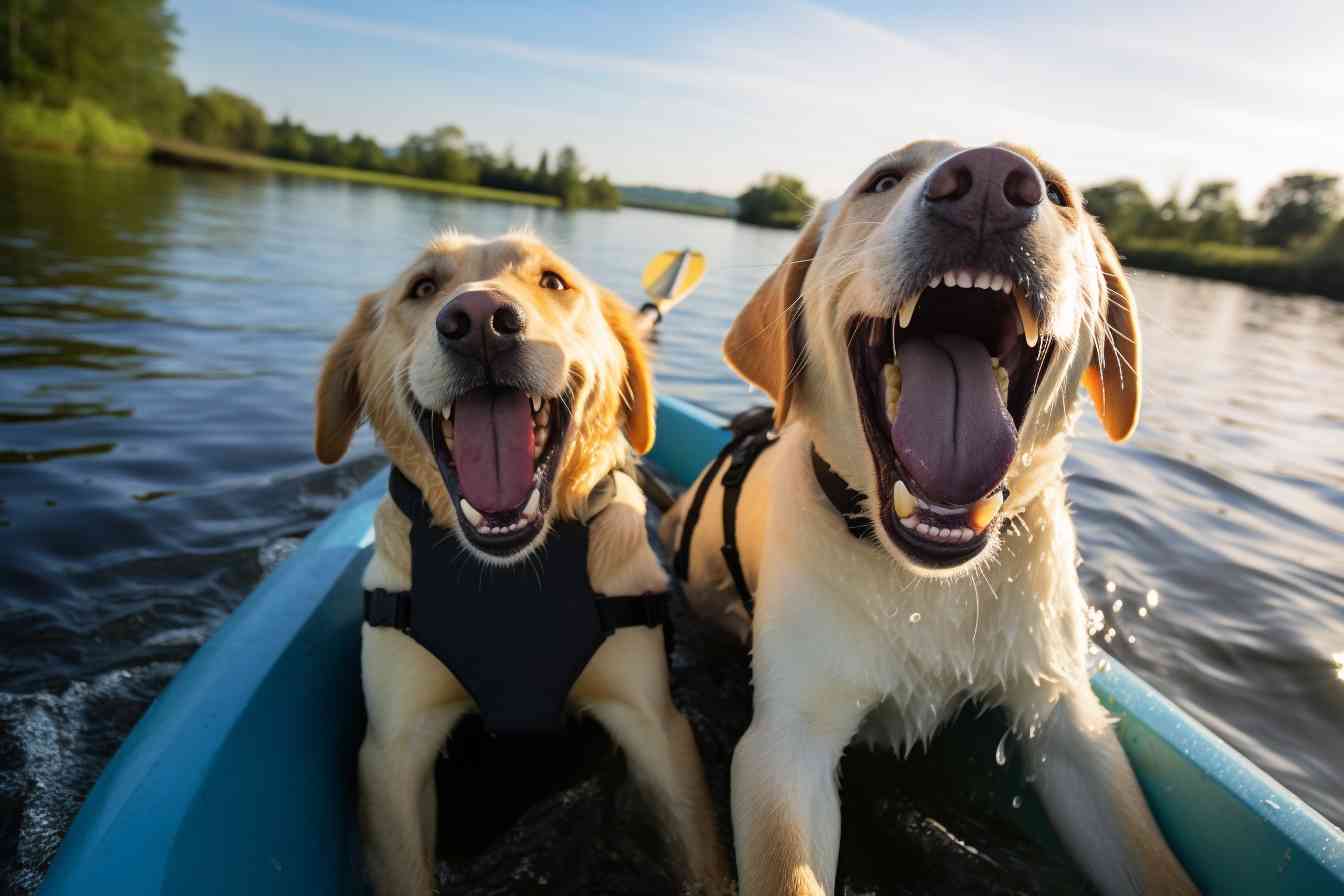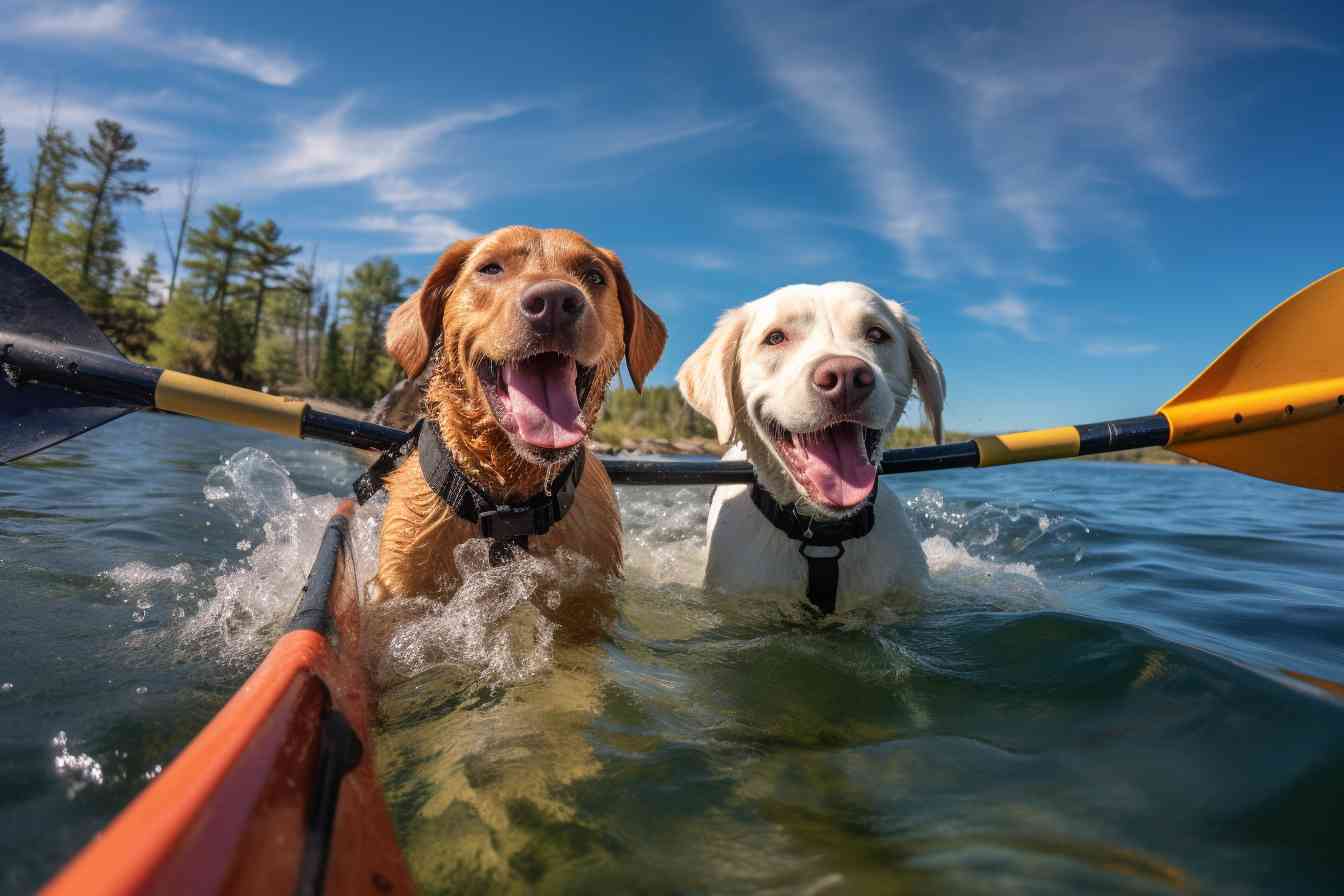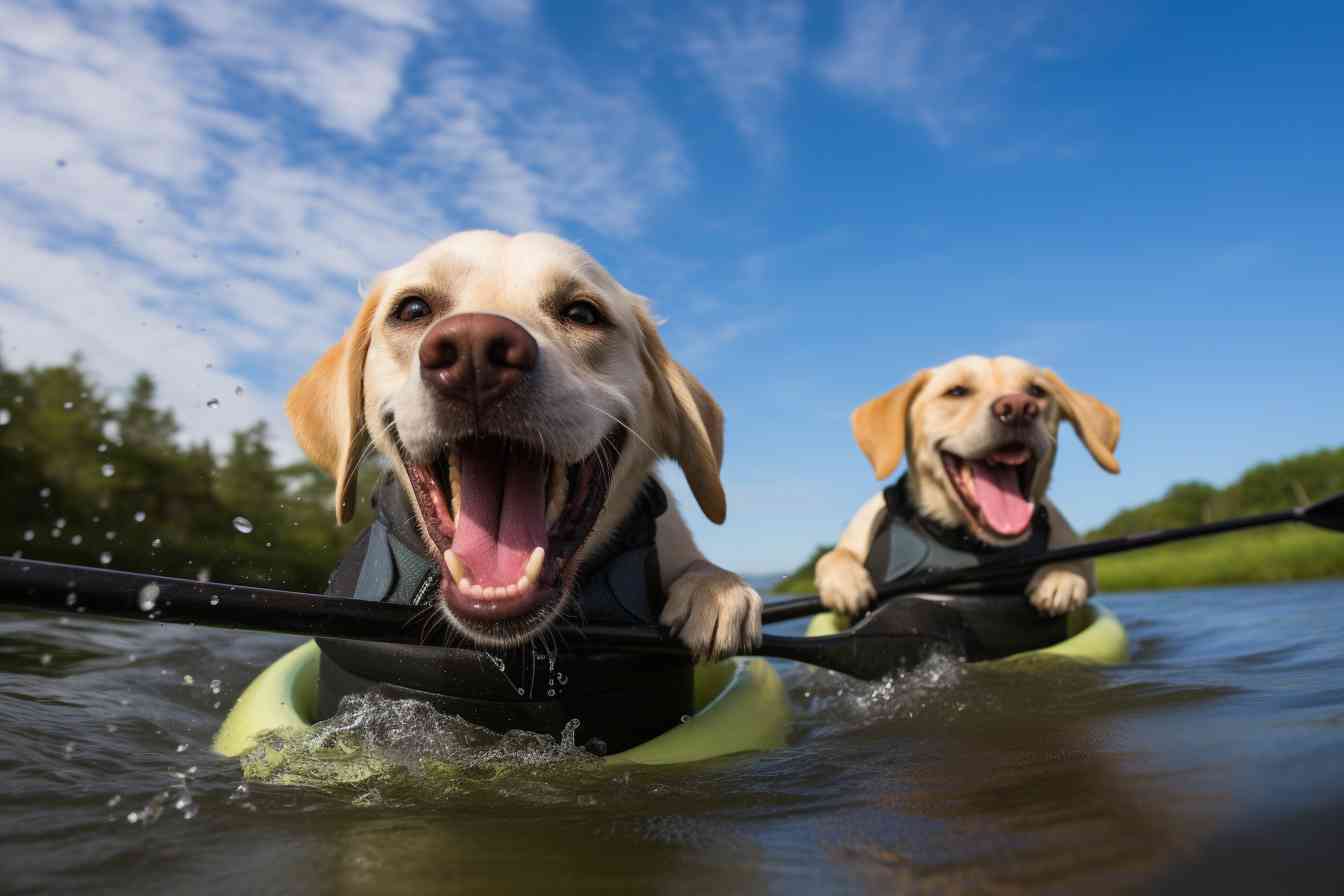Intro: Kayaking With Dogs

Well hello there, reader! You must be an adventurous soul like me if you’re thinking of combining two of life’s greatest joys: kayaking and dogs. Now, sit back and buckle up – we’re about to dive into the exciting world of kayaking with our furry friends.
Now, I’ve been kayaking for a long while, but the day I decided to bring my four-legged pal along, I must admit, it was a game-changer. There’s this additional charm when you and your pup conquer the waters together. I bet the idea of watching their ears flapping in the wind, their tail wagging in sync with your paddle strokes – I mean, doesn’t that sound wonderful?
But hold on there, partner! Before you throw on a life jacket to your pup and hit the water, there’re a few things you gotta know. Trust me, I’ve been through all the mishaps and triumphs of doggie paddling, and it’s my pleasure to share my wisdom. Now, I reckon dogs are natural-born swimmers, most of them anyway… but kayaking? That’s an entirely different beast. So, let me guide you through the ins and outs of it all.
Whoa, whoa, whoa – before we get too far ahead of ourselves, it’s essential to know if your fido friend is fit for kayak voyages. Adventure isn’t for everyone, including our dogs. If your pooch is nervous around water or gets squirmy in new situations, it’s probably best to hold off. However, if you’ve got a “go get ‘em” kind of a dog who isn’t wary of water, you’re in for quite an adventure, my friend!
Remember, the goal here is to keep things safe and fun for both you and your pup. So, keep your eyes glued to this guide for more nuggets of advice. Kayaking with dogs is not just about paddling; It’s about embracing the bizarre, the unexpected, and I dare say, the wonderfully weird.
Can My Dog Go On My Kayak?

Well, hello there! I see you’re toying with the idea of bringing your furry friend on your next kayaking adventure. Well, lucky for you, I’m here to help clear up that cloud of questions. So, can your dog hop into your kayak with you? The answer is a resounding yes! Granted, there are certainly some factors and considerations you ought to keep in mind, but generally speaking, it’s completely possible to share this paddling experience with your dog.
First things first, not to rain on your parade, but it’s critical to understand your dog’s temperament and comfort around water. A pooch that’s panic-prone around water might not be the best kayaking companion. Now, if your dog’s more of a water lover – well, Bob’s your uncle, get them on board! Keep in mind though, even water-loving dogs need to be introduced to the kayak slowly and carefully, ensuring they’re comfortable both on it and around it.
Also, it’s vital that your kayak is sufficiently roomy to comfortably and safely accommodate your canine companion. You don’t want your jaunt ruined by a precarious pup teetering on the edge! Size and stability are key factors to consider when deciding if your kayak is cut out for two.
Remember, safety should be your top priority. Just like us humans, dogs should have their own life jackets. You know, just to be on the safe side.
In conclusion, while it may seem like a daunting task, with good planning and a sprinkle of patience, kayaking with dogs can make for a paw-some adventure. After all, nothing beats exploring the great outdoors with your best friend right by your side.
What Kind Of Dog Is Best For Kayaking?

What dog breed might make the best kayaking pal, you ask? Well, honestly, it depends on a lot of factors. Let me start by saying – I’ve had my fair share of pooches on the paddleboard! And I can tell you, there’s a wide spectrum of canine cohorts that really take to the water.
Breeds with a natural affinity to water, such as Labrador Retrievers, Portuguese Water Dogs, or even Newfoundlands, could make superb kayak companions. Labradors, in particular, are known for their adaptability and exuberance for swimming, making them ideal candidates for watery adventures. They possess a double-coat that provides great insulation and helps them stay buoyant.
Now, I must interject, while we’re chatting about breeds, size matters too in this context. If you’re in a small kayak, a compact dog like a Cocker Spaniel or even a robust little French Bulldog could be the ideal fit. Their modest size makes it easier for them to fit comfortably onboard without causing too much of a balance issue.
And let’s not forget about the temperament of the dog! A calm, obedient and trainable dog is far more likely to enjoy a ride out on the kayak with you. We’re talking breeds like Golden Retrievers, Border Collies, or even the obedient and intelligent Poodles. These dogs are known to be quick learners and can easily follow instructions, making them more likely to be comfortable and safe on a kayak.
But hey, don’t take this as an absolute gospel. I mean, I’ve seen a Dachshund on a kayak who loved it more than a labrador! It breaks down to your individual dog’s personality, training, comfort around water, and your patience.
Best Inflatable Kayak For Dogs
Alright then, let’s dive right into it. Kayaking with your furry friend can be a memorable adventure, and to make sure it’s pleasant for both you and your pup, you’ll need the right equipment. More specifically, you’re going to need the .
-
Sturdiness is key: It’s fun to have your pooch along for a paddle, but remember, dogs have nails that could easily puncture your kayak if it is not strong enough. The should be constructed with heavy-duty, puncture-resistant material.
-
Maximum weight capacity: This is essential. Make sure you check the weight limit of the kayak you’re considering. It should be able to accommodate both your weight and that of your dog, plus any additional gear you might bring along.
-
Multiple Air Chambers: Opt for an inflatable kayak that has multiple air chambers. This is important for two reasons. First, it offers stability in the water. Secondly, if one chamber gets punctured, the others will keep you afloat while you steer your way to safety.
-
A spacious design: Your canine companion needs enough room to sit comfortably. Hence, opt for a spacious design, preferably one with a broad and flat bottom. This feature not only affords your pup the comfort they need, but it also instills a sense of stability that can keep them calm during the journey.
-
Safety features: Look for kayaks with built-in safety features such as grab handles and D-rings. These will allow you to secure your dog’s leash while you’re out in the water, making sure they stay safe and secure.
-
Comfortable seating: Last but absolutely not the least, ensure the inflatable kayak has comfortable seating for you as well. After all, you’re the one doing the paddling. Comfortable seating will allow you to paddle longer distances without getting uncomfortable or fatigued.
So there you have it, fellow adventurers. Keep these points in mind, and you’re bound to have a fabulous time kayaking with your dog in tow!
How Do You Secure A Dog In A Canoe?

You know, there’s nothing quite like cruising along a peaceful lake, the sun streaming down on your shoulders, with man’s best friend by your side. I mean, who wouldn’t enjoy that? But putting your furry friend in a kayak can be tricky. So how do you secure a dog in a canoe? Well, strap in, here’s the lowdown.
First off, let’s talk about your gear. You’ll need a doggy life jacket (yes, they’re a thing!) with a handle at the top. This is crucial. The life jacket keeps your pup afloat and the handle allows you to hoist him back into the kayak if he decides to go for a swim. So grip that handle and guide your furry buddy into the boat when you’re ready to go. Remember, safety first!
Next, let’s look at the seating. Position your dog in front of you, between your legs. This provides better balance and makes it easier for you to keep an eye on your canine companion. Now, we’re not saying it’ll be smooth sailing from the get-go. It’s a learning process, both for you and your dog.
Lastly, use a leash to secure your dog to the canoe. This acts as an important safety measure, preventing him from jumping out at the sight of every duck or frog. The best practice is to attach it to the life jacket, not the collar, to avoid choking hazards. Mind you, always keep the leash slack, the goal isn’t to restrict movement, but rather provide a level of security.
Trust me, being in that kayak, sharing quality time with your furry friend – it’s an experience like no other. Just remember to be patient and calm through the process, we want this to be enjoyable for both ends of the leash.
Can A Dog Fit In A Canoe?
Well, let me tell ya, this is an interesting question – can a dog fit in a canoe? I’d say they absolutely can, but it does depend on a couple of things. First, the size of your four-legged buddy. If you have a massive Saint Bernard, fitting him in a standard canoe might be quite a task. However, if your faithful companion is a petite French Bulldog or a medium-sized Husky, things could be a lot easier. Your dog’s size will determine the type of canoe you need – a wider one for bigger breeds, and a slimmer one for smaller ones.
The other factor to consider is the temperament of your pooch. Some dogs are natural water-lovers – think Labrador Retrievers, Portuguese Water Dogs, or Newfoundlanders. They might jump into a canoe without a second thought. But if your fur-friend is more of a couch-potato or not fond of water, he or she might need a bit more persuasion … and possibly a life vest for safety.
You also have to keep in mind the weight capacity of the canoe. Canoes come in different shapes and sizes, with varying weight limits. It’s important not to over-crowd the canoe or exceed its recommended weight limit. The rule of thumb is there should be enough space for you, your paddle, and your dog without the canoe becoming unstable.
And remember, when you’re out there, safety always comes first. Make sure your happy hound is comfortable and secure in the canoe. A specialized dog life jacket is a must-have for such adventures.
So long story short, yes, a dog can fit in a canoe. As long as you consider the size, temperament, and comfort of your dog, along with the canoe’s weight capacity, the two of you can share some thrilling waterborne adventures together. Dogs make any adventure more fun right? So grab a paddle – and a treat for your dog – and off you go! Give it a whirl and see how you (and your dog) take to it. Who knows, your dog may turn out to be a natural-born sailor!
Final Verdict
All right, let’s wrap things up – the final verdict on kayaking with dogs, then. It’s a resounding thumbs up from me! I mean, what’s not to love? You get to spend quality time outdoors, breathing in fresh air, surrounded by nature’s beauty, and most importantly, you’re sharing all of this with your loyal, furry friend.
Having said that, it’s not all smooth sailing…erm, or kayaking, I should say. You need to be mindful of a few things before hitting the water with your pooch. The most crucial aspect, of course, is your dog’s safety and comfort. An ill-fitted life jacket or an unaccustomed dog can turn this fun experience into a potential disaster. Always make sure your dog is comfortable and secured in the kayak. A little training goes a long way.
And then there’s you – you should be a confident kayaker as well. The waves and currents can be unpredictable. Swipe left for any doubts you may have about your paddling skills. You see, you aren’t just responsible for your safety, but also for the adorable creature relying on you.
In sum, kayaking with dogs weaves beautiful memories, brings joy, and strengthens the bond between you and your dog. But it demands responsibility. So pals, if you’ve got all bases covered, I’d say, go ahead and make a splash! Nothing beats the feeling of wind in your hair – or fur – with the rhythmic splash of the paddle and your loyal companion by your side. Just remember to put safety first – always.
Frequently Asked Questions
Q1: Is it safe to go kayaking with my dog?
Absolutely! With proper planning and safety measures, kayaking with your furry friend can be a fun and safe experience. However, it’s essential to ensure your dog is comfortable with water and can swim.
Q2: What kind of gear does my dog need for kayaking?
Safety is paramount, so a life jacket specifically designed for dogs is a must-have. Other useful items include a harness, leash, water bowl and dog-friendly sunscreen.
Q3: What type of kayak is best to use when kayaking with a dog?
A sit-on-top kayak is a great choice because it provides more room for your pup. Tandem kayaks are also a good option if you have a larger dog or multiple pets.
Q4: How do I train my dog for a kayaking trip?
Begin by familiarizing your dog with the kayak on dry land. Then slowly introduce them to water. Start with short trips and gradually increase the duration as your dog becomes more comfortable.
Q5: Can I take multiple dogs kayaking?
You bet! However, it depends on the size of your dogs and your kayak. Make sure there’s enough space for everyone to sit comfortably and safely.
Q6: What should I do if my dog jumps out of the kayak?
Don’t panic! If your dog has a life jacket on, they’ll float. Call them back to the kayak and help them aboard. It’s a good idea to practice this in a controlled environment first.
Q7: How can I make the kayak ride comfortable for my dog?
Bring along a soft mat or towel for your pup to sit on. Also, ensure there’s enough shade and fresh water, and take regular breaks so your dog can stretch and play.
Q8: How far can I kayak with my dog?
There’s no hard and fast rule, as it depends on your dog’s fitness level and enthusiasm for the adventure. Start with shorter trips and adjust based on how your dog handles them.
Q9: Should my dog wear a life jacket while kayaking?
Yes, indeed! Even strong swimmers can get tired or frightened. A life jacket ensures your dog stays afloat in any situation, adding an extra layer of safety.
Q10: Can puppies go kayaking?
Sure thing! Just like with older dogs, ensure the puppy is comfortable with water, can swim, and always has a life jacket on whilst on the kayak. Experiencing new things like kayaking can be a valuable part of a puppy’s socialization.

